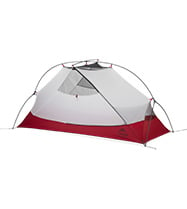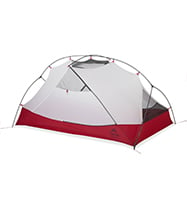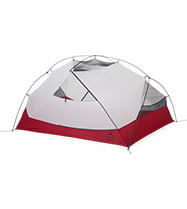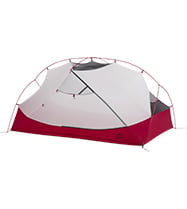The Evolution of the MSR Hubba Hubba Tent
Over the last 20 years, it’s arguable that MSR Hubba Hubba tents have helped make more dreams come true than any other. From epic thru-hikes on the world’s longest trails to that life-changing first of a “trip out west”, the Hubba Hubba has been one of the world’s best-selling tents since its inception in 2004. In this anniversary year, let’s look back at the legendary Hubba Hubba tent’s history to discover why it was such a game-changing design, and why it remains one of the most popular tents in the outdoors today.

Backpacking Tents—The Beginning
The first tents designed for pure outdoor recreation had some significant hurdles to clear from the earliest tents designed for more utilitarian pursuits like field work, hunting and military use. Rarely carried on your back and with a primary function of survival, those early tents did almost nothing well from a backpacking perspective. The tents were enormous, every component was heavy, and the fabrics of the day were susceptible to rot and rarely waterproof for long without regular treatment. Once having fun became a priority, tent designers were quick to adopt newly available technologies: fiberglass and aluminum poles replaced wood and steel; nylon fabrics replaced canvas walls.
A-frame tents became all the rage for a brief time, but they suffered in bad weather and provided little living space for their weight. The next big evolution was the geodesic dome tent, introduced in 1975, based on the foundational work of renowned architect R. Buckminster Fuller. This design remains the foundation of many large expedition tents, but it did little for backpackers as they were typically quite large and weighed substantially more than you’d want to carry any long distance. Over the next thirty years, tent designs evolved dramatically. In an effort to be lighter, most tents simply became smaller and relied on non-freestanding designs. While this reduced the need for poles, the tents could be challenging to set up in less-than-ideal conditions.
Leaping forward to 2003, the year before the Hubba Hubba, most popular lightweight backpacking tents had evolved into a wedge shape, with a large hoop around the entrance, tapering sharply toward the feet. These designs brought overall tent weight down considerably, at the sacrifice of space. They became a popular choice for backpacking, but with only one door and precious little interior room, they were hardly ‘livable’ and, at around six pounds, still shy of what could be considered lightweight.

Enter the Hubba (Hubba)
Though the hub-style pole connections are often what people assume to be the Hubba Hubba’s big innovation, other manufacturers had been employing this feature for quite a while but in a different way. What really made the original Hubba Hubba so revolutionary was figuring out a new way to use those hubs, creating a tent that was lightweight and still provided the livable features of larger tents, like headroom, two doors, roomy vestibules and an easy set-up.
The key was taking the established idea of a central hub at the apex of the tent and separating it into two hubs near each end of a rectangular footprint. This left a single overhead pole to span the tent. While this allowed a steep arc, affording lots of room on both ends, it left the sides relatively flat. The final solution to the geometry was incorporating the efficiency of a short, perpendicular “brow pole” to spread the tent out, yielding vertical sidewalls. The final tent was not only freestanding, it also allowed the addition of two doors and a relatively cavernous interior with very few poles and materials. The short brow pole saved material weight and, as a bonus, gave each door a roomy vestibule. Fast and easy nylon clips replaced confusing pole sleeves, and a monolithic pole design meant you’d never have to wonder what pole went where. The whole tent could be set up easily in a couple of minutes—all at a ground-breaking four pounds for a 2-person tent.
For some perspective, in the year it was released MSR’s lightest 2-person double-wall tent (the MSR Zoid 2) weighed 10 ounces more, had only one door, was not freestanding, and had a wedge shape that only allowed you to sit up at only one end. As you might imagine, the Hubba (the 1-person model, just three pounds) and the Hubba Hubba (2-person) were game changers.
The Reception
Truly ultralight tents often achieve their scant weights by sacrificing livability (single wall, non-freestanding, trekking pole-pitch, etc.). However, the Hubba Hubba became the first tent to leapfrog the ultralight category, offering the livability of tents that weighed two pounds more. This paradigm shift brought a new level of comfort to backpacking without a weight penalty. The result was the adoption of the Hubba Hubba as the de facto standard for thru-hikers. It was common to show up to the AT Trails Days celebration in Damascus, VA, and look out across a sea of Hubba Hubba tents. News and accolades spread quickly, and the same could be seen on the PCT and at trailheads around the world. In fact, the Hubba Hubba would become the world’s best-selling tent for many years.
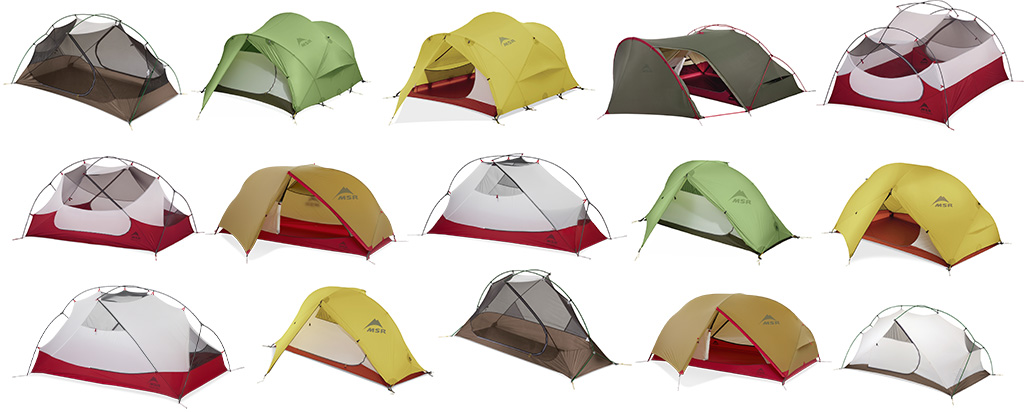
The Evolution
With the gauntlet thrown, the race was on from other manufacturers to match what the Hubba Hubba series of tents offered. Simultaneously, MSR took in a massive amount of feedback from the newly faithful in the field that would allow them to improve the Hubba tents and keep them on the leading edge of the category. If any weaknesses arose they were addressed, and customers’ suggestions were immediately considered for future revisions. More importantly, the designers knew what they wanted and worked directly with suppliers to make those improvements in materials. This was not a ‘wait-and-see’ program.
2006 brought the introduction of the 3-person Mutha Hubba tent (now the Hubba Hubba 3P), which, along with the original Hubba and Hubba Hubba, received the Backpacker Magazine Editor’s Choice award in its introductory year.
The HP
Driven by feedback from PCT thru-hikers, high-alpine users and those looking to stretch the utility of their tents into spring and fall, 2007 brought the “HP” version of every Hubba-series tent. As a testament to the original design, the only significant change was the addition of more fabric to the tent body, replacing the summer-oriented, all-mesh walls of the original. The added fabric trapped a bit more heat and afforded more protection in colder and windier weather. It also added some privacy when using the tent without the rainfly. Waterproof coatings were also upgraded, and, refusing to accept more weight to the bottom line, fabrics were upgraded to the latest ultralight denier that still met durability demands. The result was a weight reduction in every model (five ounces from the Hubba Hubba.)
With the base tent design now well-dialed for the times, the Gear Shed add-on was introduced in 2011, allowing users to add nearly 27 square feet of covered storage to the Hubba and Hubba Hubba tents.
The Hubba Hubba NX
By 2014, after tinkering with the latest fabrics and technologies, the time was ripe for the next big revision. The NX Series of Hubbas would continue the trend of cutting even more weight (now down to 3 lb. 7 oz. for the Hubba Hubba). Simultaneously, the boom in car camping and road-tripping that inspired the Gear Shed also brought about the largest Hubba tent—the 4-person Papa Hubba NX.
2019 brought the introduction of the ultralight and virtually unbreakable Easton® Syclone™ composite poles to the Hubbas and a continued refinement of the best lightweight fabrics and coatings that still meet the demands of durability and waterproof protection.
The Hubba Hubba Bikepack
Now known simply as the Hubba Hubba 1, 2 and 3 (the 4-person is no longer), 2024 brings the introduction of the Hubba Hubba 1 and 2 Bikepacking tents. The Hubba Hubba tents have remained a top choice for bikepackers for many years (see the letter evidence above), so the explosion in the sport’s popularity was the perfect excuse to finetune a tent specifically for the needs of tourers and gravel grinders. Updates on this one include a stuff sack that’s custom-built as a handlebar bag and, should you already be in love with your touring set-up, shorter pole sections that will fit easily into panniers, frame bags, etc. The fly color was also changed to a stealthy green, letting you take advantage of roadside campsites in less-than-ideal places when your legs (and butt) demand it.
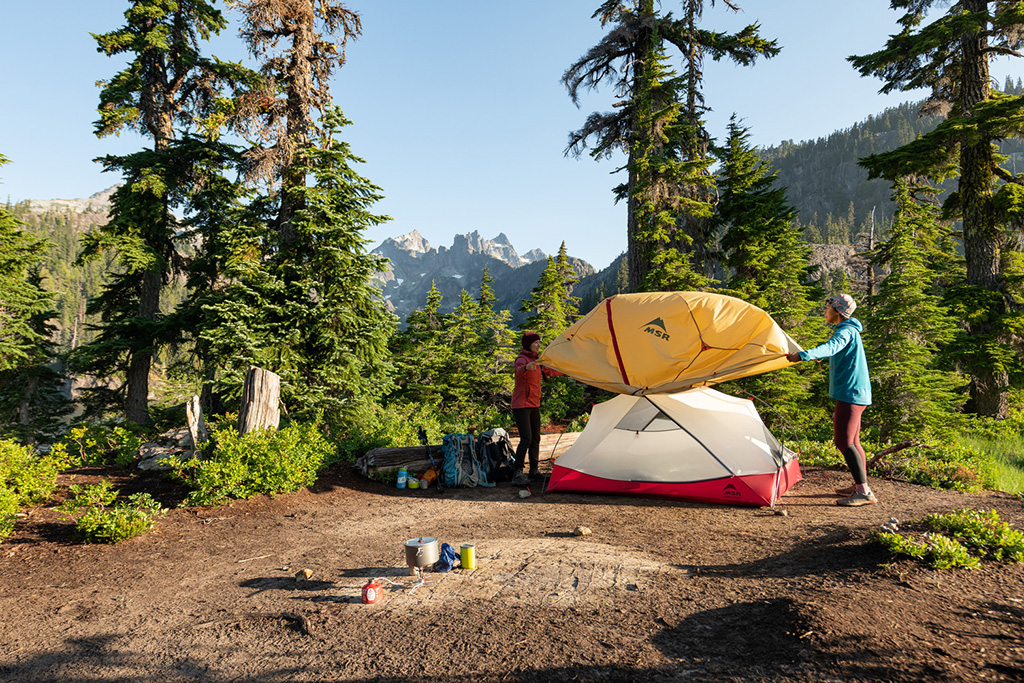
In the Field and Beyond
Though recanting the evolution of the Hubba Hubba tents is a cool trip down memory lane, by far the best thing about them is the (continuing) history of the adventures they support. From circumnavigating the globe with cyclists like Sam and Kamran to thru-hiking long trails like the PCT and New Zealand’s Te Araroa, or countless weekends close to home, the Hubba Hubba tents have achieved legendary status. This time-tested design has received numerous “Best Of” awards from the industry’s most respected outlets and an endless stream of great reviews and testimonials from customers that are a mere Google search away. The whole MSR crew feels fortunate to have had the opportunity to be a part of more than just the adventures but to be a part of people’s lives and memories that stretch far beyond the trailhead.
Related Posts:

